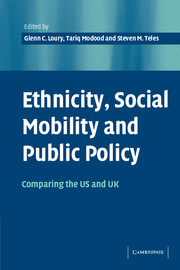Book contents
- Frontmatter
- Contents
- List of figures
- List of tables
- List of contributors
- Acknowledgements
- Introduction
- Part I Historical overviews
- Part II Informal social networks
- 4 Ethnicity as social capital: community-based institutions and embedded networks of social relations
- 5 Intergenerational mobility and racial inequality in education and earnings
- 6 Social integration and social mobility: spatial segregation and intermarriage of the Caribbean population in Britain
- 7 Ghettos and the transmission of ethnic capital
- 8 Family formulation in multicultural Britain: diversity and change
- Part III Formal structures
- Part IV Political institutions and processes
- Part V Normative analysis
- Author index
- Subject index
- References
5 - Intergenerational mobility and racial inequality in education and earnings
Published online by Cambridge University Press: 22 September 2009
- Frontmatter
- Contents
- List of figures
- List of tables
- List of contributors
- Acknowledgements
- Introduction
- Part I Historical overviews
- Part II Informal social networks
- 4 Ethnicity as social capital: community-based institutions and embedded networks of social relations
- 5 Intergenerational mobility and racial inequality in education and earnings
- 6 Social integration and social mobility: spatial segregation and intermarriage of the Caribbean population in Britain
- 7 Ghettos and the transmission of ethnic capital
- 8 Family formulation in multicultural Britain: diversity and change
- Part III Formal structures
- Part IV Political institutions and processes
- Part V Normative analysis
- Author index
- Subject index
- References
Summary
Introduction
Most analyses of group differences in earnings examine a cross-section of the population in a given year or compare across two or more different years. A full understanding of the relative standing of racial or other groups requires, however, an analysis of the size and determinants of intergenerational mobility. If an individual's position in the distribution of earnings is determined largely by that of his parents, then the ability of disadvantaged groups to alter their economic status over time will be hampered. In addition, uncovering the causes of intergenerational mobility is necessary to determine to what extent the distribution of society's resources is fair and to find out which policies are most likely to change the circumstances of those at the bottom. In order to address these issues, this paper first discusses the overall level of intergenerational mobility in years of schooling and income. It then outlines factors that either magnify or reduce the effects for African-Americans and ethnic groups in the United States.
The theoretical economics literature examining the effects of family of origin on children's outcomes states that children's earnings and income depend on investment in human capital (as measured, for example, by years of schooling). The amount of that investment depends, in part, on children's endowed capacities and, in part, on parents' earnings and the quantity and quality of other nonpecuniary resources. Literature in sociology and psychology specifies in more detail the exact nature of these nonpecuniary resources. A variety of different models are offered.
- Type
- Chapter
- Information
- Ethnicity, Social Mobility, and Public PolicyComparing the USA and UK, pp. 160 - 177Publisher: Cambridge University PressPrint publication year: 2005



